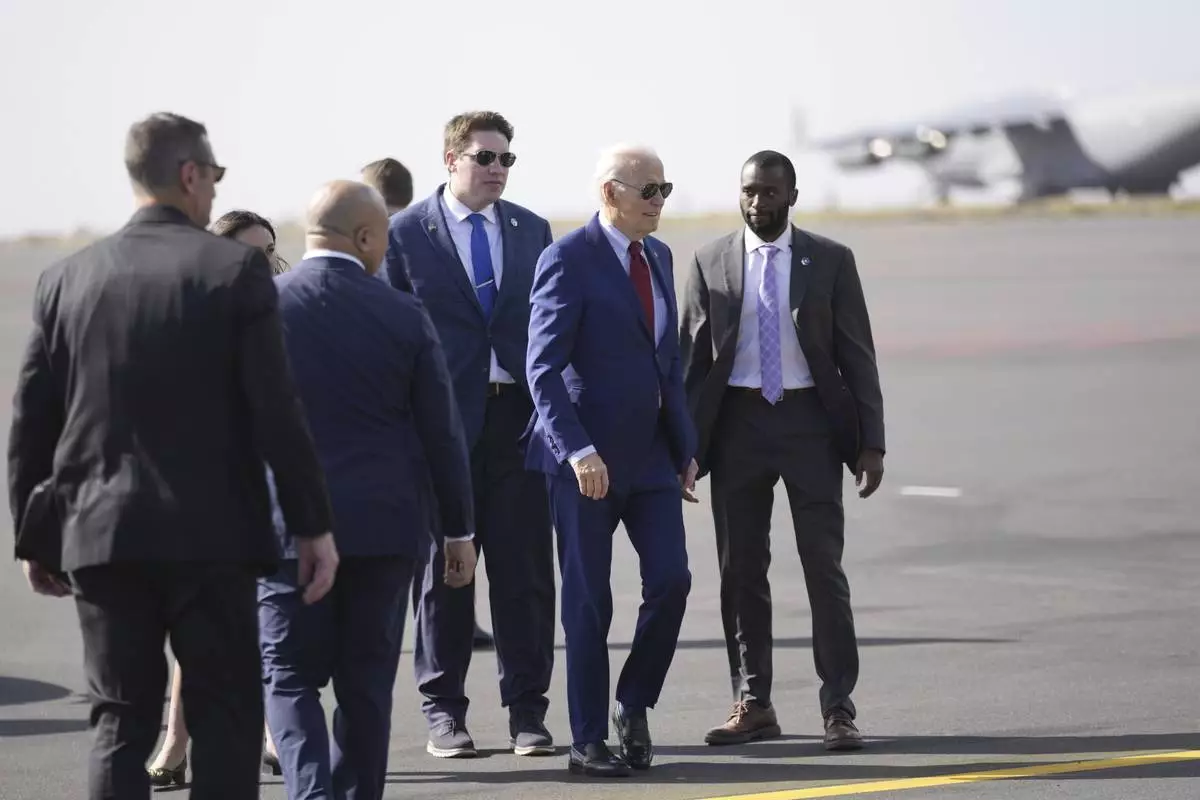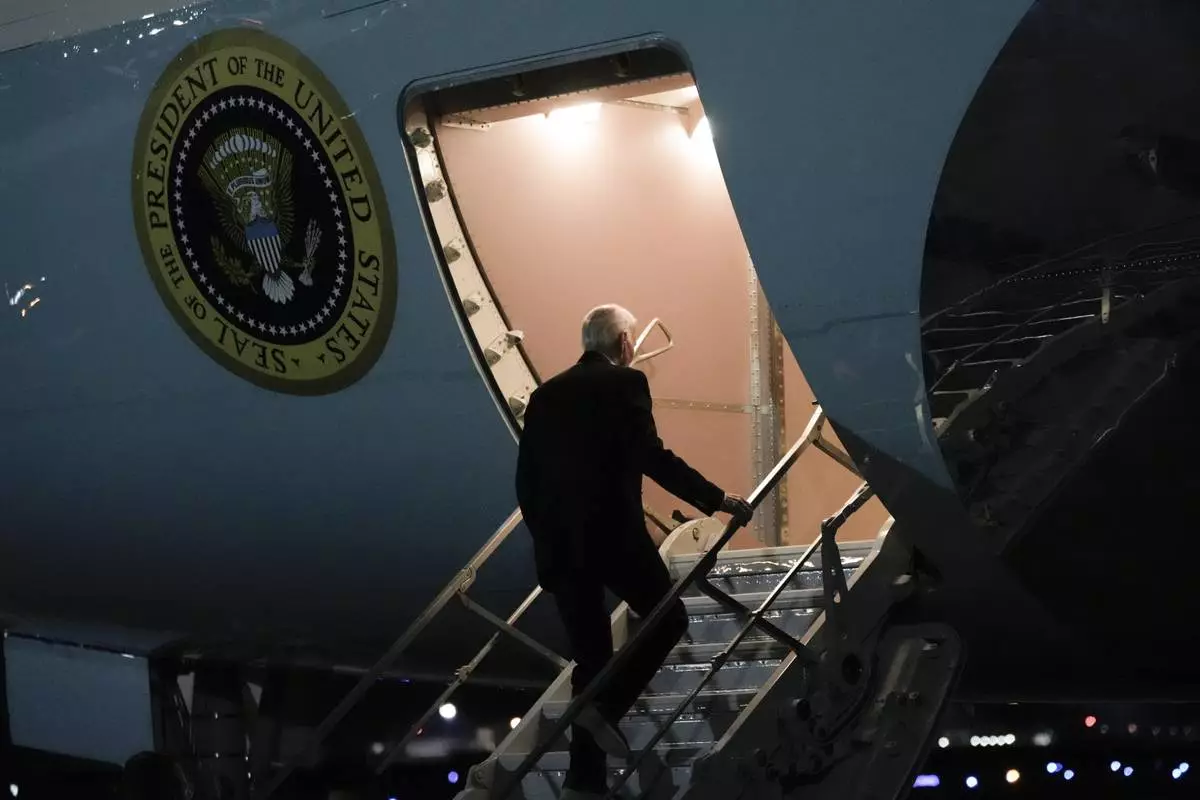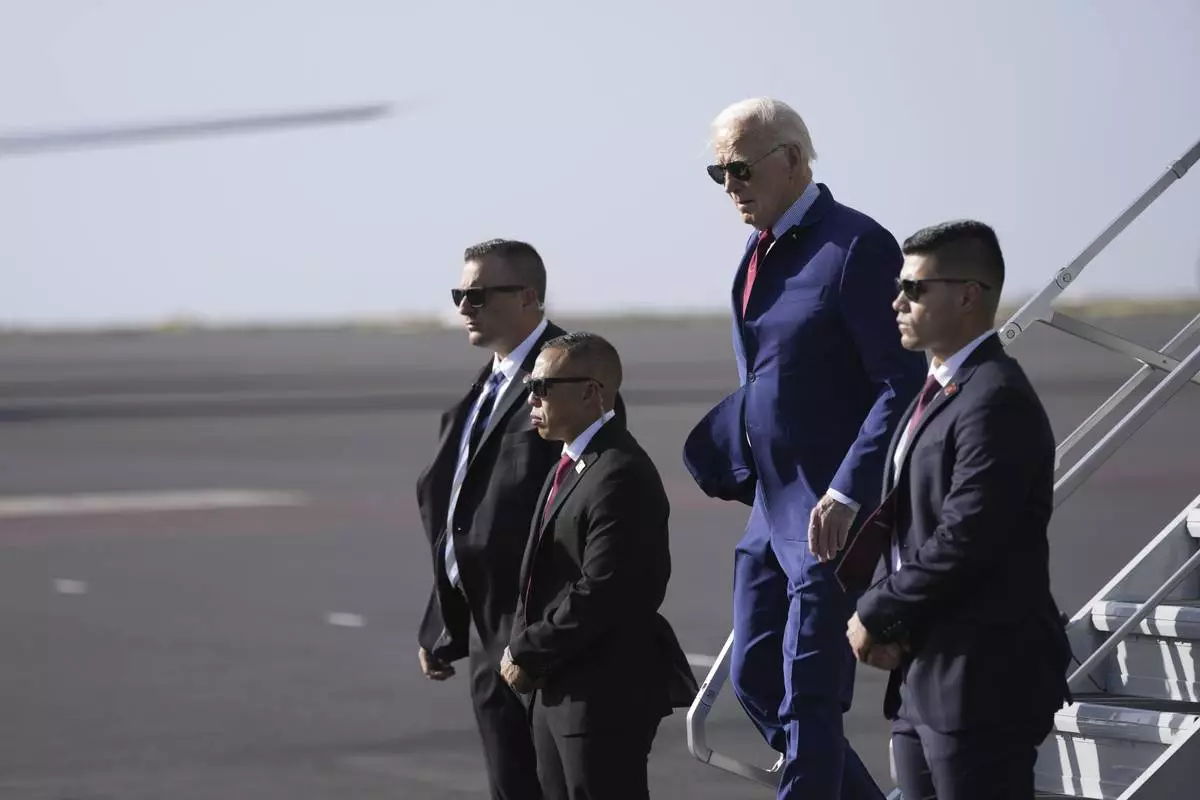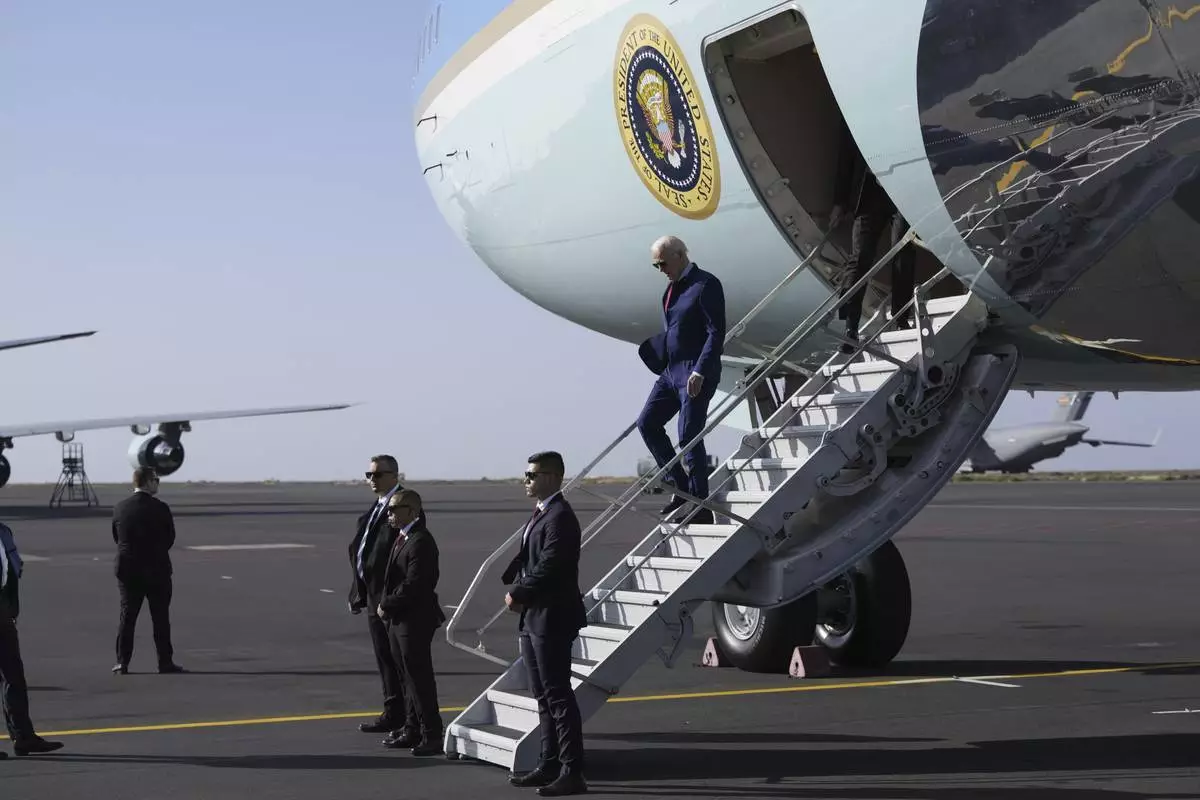Marie Dageville and her husband Benoit Dageville became billionaires overnight when his data cloud company, Snowflake, went public in September 2020. After that life changing moment, Marie, a former hospice nurse, then set out to learn how to urgently give away that new fortune.
“We need to redistribute what we have that is too much,” she said in an interview with The Associated Press from her home in Silicon Valley.
While many say giving away a lot of money is hard, that is not Dageville’s perspective. Her advice is to just get started.
America's wealthiest people have urged each other to give away more of their money since at least 1889, the year Andrew Carnegie published an essay entitled, “The Gospel of Wealth." He argued that the richest should give away their fortunes within their lifetimes, in part to lessen the sting of growing inequality.
A whole industry of advisers, courses and charitable giving vehicles has grown to help facilitate donations from the wealthy, to some extent prompted by the Giving Pledge, an initiative housed at the Bill & Melinda Gates Foundation. In 2010, Warren Buffett, Bill Gates and Melinda French Gates invited other billionaires to promise to give away half of their fortunes in their lifetimes or in their wills. So far, 244 have signed on.
So, what stands in the way of the wealthiest people giving more and giving faster?
Philanthropy advisers say some answers are structural, like finding the right vehicles and advisers, and some have to do with emotional and psychological factors, like negotiating with family members or wanting to look good in the eyes of their peers.
“It’s like a massive, perfect storm of behavioral barriers,” said Piyush Tantia, chief innovation officer at ideas42, who recently contributed to a report funded by the Gates Foundation looking at what holds the wealthiest donors back.
He points out that unlike everyday donors, who may give in response to an ask from a friend or family member, the wealthiest donors end up deliberating much more about where to give.
“We might think, ‘It’s a billionaire. Who cares about a hundred grand? They make that back in the next 15 minutes'," he said. "But it doesn’t feel like that.”
His advice is to think about philanthropy as a portfolio, with different risk levels and strategies ideally working in concert. That way it's less about the outcome of any single grant and more about the cumulative impact.
Marie Dageville said she benefited from speaking with other people who had signed the Giving Pledge, especially one person who urged her to make general operating grants, meaning the organization can choose how to spend the funds themselves. She trusts nonprofits close to the communities they serve to know best how to spend the money and said she is not held back by a worry that they will misuse it.
“If you are in the position where you are at now — able to redistribute this fortune — either you took risks or someone took risks on you," she said, adding. “So why can’t you take some risk (in your philanthropy)?”
Dageville also thinks there is too much focus on the wants of the donors, rather than the needs of the recipients.
Private and open conversations between donors also help them move forward, advisers have found. The Center for High Impact Philanthropy at University of Pennsylvania runs an academy that convenes very wealthy donors, their advisers and the heads of foundations to learn together in cohorts.
Kat Rosqueta, the center's executive director, said donors like MacKenzie Scott, the author and now billionaire ex-wife of Amazon founder Jeff Bezos, show it's possible to move quickly.
“Do all the ultra high net worth funders have to go slower than MacKenzie Scott? No,” she said.
But she said, sometimes donors struggle with seeing how to make a difference, given that philanthropic funding is tiny compared to government spending or the business sector.
Cara Bradley, deputy director of philanthropic partnerships at the Gates Foundation, said the scrutiny of billionaire philanthropy also means they feel a huge responsibility to use their funds as best as possible.
“They’ve signed a pledge genuinely committed to trying to give away this tremendous amount of wealth. And then, people can get stuck because life gets busy. This is hard. Philanthropy is a real endeavor,” she said.
It is also not easy to conduct empirical research on billionaires, said Deborah Small, a marketing professor at Yale School of Management. But she said, in general, current social norms value anonymity in giving, which is seen as being more virtuous because the donor isn't recognized for their generosity.
“It would be better for causes, and for philanthropy as a whole, if everybody was open about it because that would create the social norm that this is an expectation in society,” she said.
Jorge Pérez, founder and CEO of the real estate developer Related Group, along with his wife, Darlene, was early to join the Giving Pledge in 2012. In an interview with The Associated Press, Pérez said he frequently speaks with his peers about giving more and faster.
“I think people have stopped taking my calls,” he joked.
He also has engaged his adult children in their philanthropy, much of which they conduct through The Miami Foundation. He said they decided to draw on the expertise of the foundation, rather than starting their own organizations, to speed along the evaluation of potential grantees.
Even before the Pérezes joined the Giving Pledge, they were major supporters of the arts and of scholarships in Miami, where they are based. In 2011, the couple donated their art collection along with cash, together worth $40 million, to the art museum, which was renamed the Pérez Art Museum Miami after the gift.
Pérez said he gives because he thinks very unequal societies are not sustainable and because he wants to leave behind a legacy.
“I keep on selling the idea that you’re giving because of very selfish reasons,” he said. “One is it makes you feel good. But two, particularly in the city or the state or the country that you’re going to live in, in the long run, this is going to make a huge difference in making our society fairer, better and more progressive and probably lead to greater economic wealth.”
The Associated Press receives financial support for news coverage in Africa from the Bill & Melinda Gates Foundation.
Associated Press coverage of philanthropy and nonprofits receives support through the AP’s collaboration with The Conversation US, with funding from Lilly Endowment Inc. The AP is solely responsible for this content. For all of AP’s philanthropy coverage, visit https://apnews.com/hub/philanthropy.

FILE - Jorge M. Perez, Chairman and Chief Executive Officer of Related Group, walks the sidelines before the start of an NFL football game between the Miami Dolphins and the Carolina Panthers, Oct. 15, 2023, in Miami Gardens, Fla. (AP Photo/Wilfredo Lee, File)

Marie Dageville poses for a portrait in San Carlos, Calif., Thursday, Nov. 14, 2024. (AP Photo/Jeff Chiu)

Marie Dageville poses for a portrait in San Carlos, Calif., Thursday, Nov. 14, 2024. (AP Photo/Jeff Chiu)

Marie Dageville poses for a portrait in San Carlos, Calif., Thursday, Nov. 14, 2024. (AP Photo/Jeff Chiu)
LUANDA, Angola (AP) — President Joe Biden arrived in Angola on Monday for his long-awaited first presidential visit to sub-Saharan Africa and will use the three-day trip to counter China’s influence by highlighting an ambitious U.S.-backed railway project.
The Lobito Corridor railway redevelopment in Zambia, Congo and Angola aims to advance U.S. presence in a region rich in the critical minerals used in batteries for electric vehicles, electronic devices and clean energy technologies.
Biden first stopped in the Atlantic Ocean island nation of Cape Verde for a brief, closed-door meeting with Prime Minister Ulisses Correia e Silva. In Angola, Biden plans to meet with Angolan President João Lourenço, visit the National Slavery Museum and travel to the port city of Lobito for a look at the rail project.
His visit comes with weeks left in his presidency, as Republican Donald Trump prepares to take office on Jan. 20.
Biden promised to visit Africa last year after reviving the U.S.-Africa Summit in December 2022. The trip was pushed back to 2024 and delayed again this October because of Hurricane Milton, reinforcing a sentiment among Africans that their continent is still low priority for Washington.
The last U.S. president to visit sub-Saharan Africa was Barack Obama in 2015. Biden did attend a United Nations climate summit in Egypt in North Africa in 2022.
“I just kind of push back on the premise that this is some Johnny-come-lately trip at the very end,” national security spokesman John Kirby told reporters on board Air Force One on the way to Angola, noting that top administration officials had visited Africa, including Vice President Kamala Harris. “This is something he (Biden) has been focused on since he became president of the United States.”
Critical minerals are a key field for U.S.-China competition and China has a stranglehold on Africa’s critical minerals.
The U.S. has for years built relations in Africa through trade, security and humanitarian aid. The 800-mile (1,300-kilometer) railway upgrade is a different move and has shades of China’s Belt and Road foreign infrastructure strategy that has surged ahead.
The Biden administration has called the corridor one of the president’s signature initiatives, yet Lobito’s future and any change in the way the United States engages with a continent of 1.4 billion that’s leaning heavily toward China depends on the incoming administration of President-elect Trump.
“President Biden is no longer the story,” said Mvemba Dizolele, the director of the Africa Program at the Center for Strategic and International Studies, a Washington-based think tank. “Even African leaders are focused on Donald Trump.”
The U.S. has committed $3 billion to the Lobito Corridor and related projects, administration officials said, alongside financing from the European Union, the Group of Seven leading industrialized nations, a Western-led private consortium and African banks.
“A lot is riding on this in terms of its success and its replicability,” said Tom Sheehy, a fellow at the United States Institute of Peace, a nonpartisan federal research institution.
He called it one of the flagships for the G7’s new Partnership for Global Infrastructure and Investment, which was driven by Biden and aims to reach other developing nations as a response to China’s Belt and Road.
Many are optimistic that the Lobito project, which isn’t due for completion until well after Biden has left office, will survive a change of administration and be given a chance. It goes some way to blunting China, which has bipartisan backing and is high on Trump’s to-do list.
“As long as they keep labeling Lobito one of the main anti-China tools in Africa, there is a certain likelihood that it’s going to keep being funded,” said Christian-Géraud Neema, who analyzes China-Africa relations.
Kirby said the Biden administration hoped Trump and his team saw the value in Lobito but “we are still in office. We still have 50 days. This is a key major development not just for the United States and our foreign policy goals in Africa, but for Africans.”
The Lobito Corridor will be an upgrade and extension of a railway line from the copper and cobalt mines of northern Zambia and southern Congo to Angola’s Atlantic Ocean port of Lobito, a route west for Africa’s critical minerals. It also ultimately aims to extend from Zambia and Congo to Africa’s east coast through Tanzania and be a coast-to-coast rail link.
While Biden’s administration called it a “game-changer” for U.S. investment in Africa, it’s little more than a starting point for the U.S. and its partners with China dominant in the mining in Zambia and Congo. Congo has more than 70% of the world’s cobalt, most of which is heading to China to reinforce its critical mineral supply chain that the U.S. and Europe have to rely on.
Lobito was made possible by some American diplomatic success in Angola that led to a Western consortium winning the bid for the project in 2022 ahead of Chinese competition, a surprise given Angola’s long and strong ties with Beijing. China financed a previous redevelopment of the railway.
The Biden administration accelerated American outreach to Angola, turning around what was an antagonistic relationship three decades ago when the U.S. armed anti-government rebels in Angola’s civil war. U.S.-Angola trade was $1.77 billion last year, while the U.S. has a stronger stake in regional security through a strategic presence on the Atlantic Ocean, and Lourenço’s role mediating in a conflict in eastern Congo.
In Angola, Biden will announce new developments on health, agribusiness, security cooperation as well as the Lobito Corridor, White House officials said.
The visit, the first by a sitting U.S. president to Angola, will “highlight that remarkable evolution of the U.S.-Angola relationship,” said Frances Brown, a special assistant to the president and senior director for African affairs at the National Security Council.
It will also draw attention to a perennial challenge for America’s value-based diplomacy in Africa. International rights groups have used Biden’s trip to criticize the Lourenço government’s authoritarian shift. Political opponents have been imprisoned and allegedly tortured, while security and other laws have been passed in Angola that severely restrict freedoms, throwing some scrutiny on Washington’s new African partnership.
Imray reported from Cape Town, South Africa. Fatima Hussein in West Palm Beach, Florida, contributed to this report.

President Joe Biden gets ready to depart from Amilcar Cabral international airport on Sal island, Cape Verde Monday, Dec. 2, 2024, en route to Angola as he makes his long-promised visit to Africa. (AP Photo/Ben Curtis)

President Joe Biden is greeted by Cape Verde's Prime Minister Ulisses Correia e Silva at Amilcar Cabral international airport on Sal island, Cape Verde Monday, Dec. 2, 2024, en route to Angola as he makes his long-promised visit to Africa. (AP Photo/Ben Curtis)

President Joe Biden boards Air Force One at Amilcar Cabral international airport on Sal island, Cape Verde Monday, Dec. 2, 2024, en route to Angola as he makes his long-promised visit to Africa. (AP Photo/Ben Curtis)

President Joe Biden boards Air Force One at Amilcar Cabral international airport on Sal island, Cape Verde Monday, Dec. 2, 2024, en route to Angola as he makes his long-promised visit to Africa. (AP Photo/Ben Curtis)

President Joe Biden gets ready to depart from Amilcar Cabral international airport on Sal island, Cape Verde Monday, Dec. 2, 2024, en route to Angola as he makes his long-promised visit to Africa. (AP Photo/Ben Curtis)

President Joe Biden arrives at Amilcar Cabral international airport on Sal island, Cape Verde Monday, Dec. 2, 2024, en route to Angola as he makes his long-promised visit to Africa. (AP Photo/Ben Curtis)

President Joe Biden speaks with Cape Verde's Prime Minister Ulisses Correia e Silva , right, and Jose Luis Livramento, Cabo Verde Ambassador to the U.S at Amilcar Cabral international airport on Sal island, Cape Verde Monday, Dec. 2, 2024, en route to Angola as he makes his long-promised visit to Africa. (AP Photo/Ben Curtis)

With Jose Luis Livramento, Cabo Verde Ambassador to the U.S looking on, President Joe Biden is greeted by Cape Verde's Prime Minister Ulisses Correia e Silva at Amilcar Cabral international airport on Sal island, Cape Verde Monday, Dec. 2, 2024, en route to Angola as he makes his long-promised visit to Africa. (AP Photo/Ben Curtis)

President Joe Biden walks out to speak in the Rose Garden of the White House in Washington Tuesday, Nov. 26, 2024. (AP Photo/Ben Curtis)

FILE - Republican presidential nominee former President Donald Trump watches a video screen at a campaign rally at the Salem Civic Center, in Salem, Va, Nov. 2, 2024. (AP Photo/Evan Vucci, File)

President Joe Biden boards Air Force One at Joint Base Andrews, Md., Sunday, Dec. 1, 2024, en route to Angola as he makes his long-promised visit to Africa. (AP Photo/Ben Curtis)

President Joe Biden is greeted by Cape Verde's Prime Minister Ulisses Correia e Silva at Amilcar Cabral international airport on Sal island, Cape Verde Monday, Dec. 2, 2024, en route to Angola as he makes his long-promised visit to Africa. (AP Photo/Ben Curtis)

President Joe Biden is greeted by Cape Verde's Prime Minister Ulisses Correia e Silva at Amilcar Cabral international airport on Sal island, Cape Verde Monday, Dec. 2, 2024, en route to Angola as he makes his long-promised visit to Africa. (AP Photo/Ben Curtis)

President Joe Biden walks from Air Force One at Amilcar Cabral international airport on Sal island, Cape Verde Monday, Dec. 2, 2024, en route to Angola as he makes his long-promised visit to Africa. (AP Photo/Ben Curtis)

President Joe Biden walks from Air Force One at Amilcar Cabral international airport on Sal island, Cape Verde Monday, Dec. 2, 2024, en route to Angola as he makes his long-promised visit to Africa. (AP Photo/Ben Curtis)

President Joe Biden walks from Air Force One at Amilcar Cabral international airport on Sal island, Cape Verde Monday, Dec. 2, 2024, en route to Angola as he makes his long-promised visit to Africa. (AP Photo/Ben Curtis)

President Joe Biden speaks with Cape Verde's Prime Minister Ulisses Correia e Silva, right, and Jose Luis Livramento, Cabo Verde Ambassador to the U.S at Amilcar Cabral international airport on Sal island, Cape Verde Monday, Dec. 2, 2024, en route to Angola as he makes his long-promised visit to Africa. (AP Photo/Ben Curtis)






























